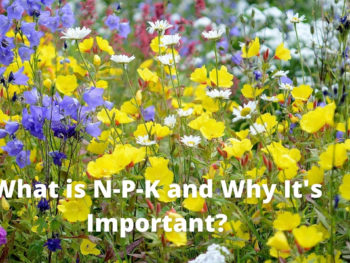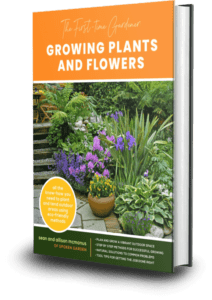Learn what N-P-K is and how to apply it to your garden plants on this quick garden minute podcast.
Subscribe on iTunes Stitcher Spotify
Watch Us on YouTube

Fertilizer can help plants grow tall, be vigorous, have bright flowers, and promote healthy root growth, plus more.
Today’s Topic:
What is N-P-K and Why You Should Care?
In this podcast, you’ll learn what N-P-K is for plant fertilizer and why it’s important to know for your plants health.
What You’ll Learn:
- What N-P-K means.
- What each nutrient is generally known for to help plant health and growth.
- Resources and links for more information.
Resources
Some of the resources and products below may be affiliate links, meaning we might get paid a commission (at no extra cost to you) if you use that link to make a purchase.
- 6 Common Watering Mistakes and How to Avoid Them – DIY Garden Minute Ep. 146 (podcast)
- Checkout and Pre-Order our New Book: 1st Time Gardener: Growing Plants and Flowers. To Be Released February 9th, 2021!
- Want to get started, but not sure on what? Go to our Start-Here Page!
What is N-P-K?
The ratio of numbers on a fertilizer bag or container represent the percentage of Nitrogen (N), Phosphorus (P), and Potassium (K) in that specific fertilizer. The percentage is the amount of one of these three nutrients in any quantity you apply to your garden plants. Note here that you should always follow the directions on the label so you don’t over fertilize your plants.
Each of these nutrient works in a plant in many different ways to keep plants healthy, but they are thought to have specific benefits, too, that you can see in your plants.
N-P-K Benefits Are:
-
Nitrogen is generally known to stimulate more leaves, stems, and help with chlorophyll production helping most plants turn more green in color.
-
Phosphorus is generally known to stimulate a plant to grow more roots and help with flower development.
-
Potassium is also generally known to help boost plants immune systems, be more tolerant of extreme temperatures, and help plants breath more efficiently through their leaves.
The order of the three number ratio for any fertilizer never changes to always represent nitrogen first, phosphorus second, and potassium third.
Examples of balanced fertilizers are 4-4-4 or 10-10-10.
You would want to use a balanced or close to balanced fertilizer to keep your plants overall health and vigor high with lots of flowers.
- You can find balanced fertilizers at your local nurseries and at the large box-stores under many different names. Also online. here are a few we like:
Examples of unbalanced fertilizers are 20-0-0 or 14-0-0 where having a higher nitrogen number with the phosphorus and potassium numbers very low or zero.
You would want to use an unbalanced fertilizer like these if you wanted to only green up your grass or specific plants needing to green up and grow more leaves or biomass.
- You can find these unbalanced fertilizers also at your local nurseries and at large box-stores under a couple different names. Some might be online. Although we do not use these, here are a few to see:
And that’s why you should know what N-P-K means and how you can use it in your garden.
If you aren’t sure where to start learning about garden care, go to our Start Here page at spokengarden.com/start-here .
And, if you have questions about using fertilizer in your garden, we are here to help, so please email us.
References:
- Farmer’s Almanac – NPK Ratio: What Do Numbers on Fertilizers Mean?
- Plant Care Today – Potassium: The Importance of Potassium For Plants
Thanks for Listening!!!
That’s all for this podcast episode! You can find other beginning gardener topics on our podcast page by clicking here or go to SpokenGarden.com and click on the “Listen” tab. Also find us on your favorite podcast platform and smart speaker!
If you want to know more about growing plants and flowers, check out our new book The First-Time Gardener: Growing Plants and Flowers: All the Know-how you need to plant and tend outdoor areas using eco-friendly methods. You can pre-order now so you get your copy on our release date of February 9th, 2021.
Share Your Thoughts:
- Leave a note in the comment section below.
- Leave comments/ suggestions at Seanandallison@eseospace.dev
- Share our show or follow us on Instagram, Twitter, Facebook, or Pinterest.
To Help Us Out:
- Leave a review on iTunes. Your ratings and reviews really help us reach new listeners to help them in their gardens!
*Spoken Garden is a participant in the Amazon Services LLC Associates Program, an affiliate advertising program designed to provide a means for sites to earn advertising fees by advertising and linking to Amazon.com.






